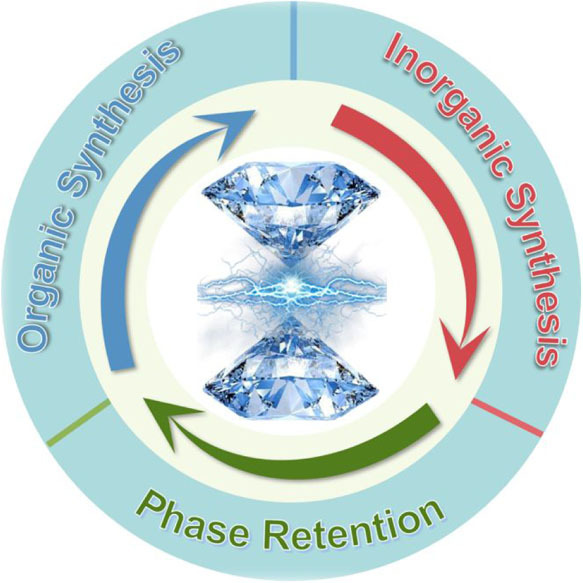Recently, Professor Guanjun Xiao and Professor Bo Zou from Jilin University, along with Dr. Kuo Li from Beijing High Pressure Science Research Center and Professor Man-Rong Li from Hainan University published a Mini-Review titled “Chemical Synthesis Driven by High Pressure” in CCS Chemistry. The article provides a comprehensive review of the current progress and future prospects of high-pressure-driven chemical synthesis, offering constructive guidance for the design and development of high-performance materials.

Background:
The chemical synthesis of functional materials is closely linked to national defense, healthcare, economy, and people's livelihoods. Traditional organic and inorganic materials are approaching their performance limits. As a result, there is an urgent need to design and develop new functional materials, which has significant implications for sustainable development. The generation of internal chemical pressure and the application of external pressure are two strategies that can effectively promote structural changes within materials, leading to the creation of new materials. However, generating chemical internal pressure often results in changes in chemical composition, whereas external pressure can effectively prevent these compositional changes. To date, the synthesis and application of numerous organic and inorganic compounds under high pressure have been realized. High pressure can significantly alter the structure and properties of materials by shortening atomic distances, inducing phase transitions, regulating chemical reactions, enhancing material performance, and simulating deep Earth environments, making it a powerful tool for the chemical synthesis of new functional materials.
Highlights:
This review aims to systematically summarize the current progress and future prospects of high-pressure-driven chemical synthesis, providing additional references for the development of high-pressure chemistry and further promoting interdisciplinary research in future synthetic chemistry. The article focuses on two main aspects of high-pressure-guided chemical synthesis:
High-Pressure Chemical Synthesis: The authors summarize some high-performance organic and inorganic materials synthesized under high pressure and discuss their potential synthesis mechanisms. This provides guidance for the design and synthesis of new functional organic and inorganic materials.
High-Pressure Phase Trapping: The article systematically presents and outlines three effective strategies for trapping high-pressure metastable phases at ambient pressure, focusing on how to obtain "useful" materials that are difficult to achieve under conventional conditions. These strategies include the effects of nanoscale dimensions, spatial steric hindrance, and hydrogen bond synergy.
Summary and Outlook:
High-pressure-driven chemical synthesis is an important direction in high-pressure chemistry. High-pressure synthesis and the trapping of high-performance high-pressure phases have provided new dimensions for discovering new materials and phases, greatly enhancing our understanding of materials. Researchers have successfully controlled the preparation of superhard materials, superconducting materials, thermoelectric materials, energetic materials, and optoelectronic materials using large-volume pressure vessels and diamond anvil cells. Professor Bo Zou's team has also explored strategies like nanoscale effects, spatial steric hindrance, and hydrogen bond synergy for trapping high-pressure phases. The successful trapping of high-performance high-pressure phases has made large-scale production possible through the use of large-volume pressure vessels. Despite these great successes in high-pressure chemistry, challenges remain, including the precise atomic-scale identification of high-pressure products, functional exploration of high-quality products, the relatively high experimental costs, the complex operation of high-pressure equipment, and the lack of in-situ microscopic characterization techniques for accurately identifying and analyzing trapped amorphous high-pressure phases. Therefore, future research should focus on simplifying high-pressure equipment, breaking through the high-pressure limits of large volumes, and developing various in-situ high-pressure characterization techniques.
The article is published as a Mini Review in CCS Chemistry. The doctoral students Wenya Zhao (Jilin University), Jie Zhang (Beijing High Pressure Science Research Center), and Zhongxiong Sun (Sun Yat-sen University) are the joint first authors, while Professors Guanjun Xiao and Bo Zou (Jilin University), Dr. Kuo Li (Beijing High Pressure Science Research Center), and Professor Man-Rong Li (Hainan University) are the joint corresponding authors.
Article Details:
Chemical Synthesis Driven by High Pressure
Wenya Zhao†, Jie Zhang†, Zhongxiong Sun†, Guanjun Xiao*, Haiyan Zheng, Kuo Li*, Man-Rong Li*, and Bo Zou*
Cite This: CCS Chem. 2025, Just Published. DOI: 10.31635/ccschem.025.202405293
Link: https://doi.org/10.31635/ccschem.024.202405293